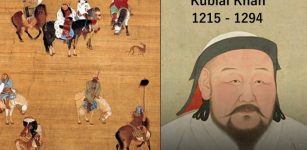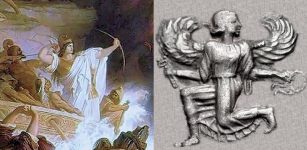Ancient Egyptians Played Bowling 5,000 Years Ago
A. Sutherland - AncientPages.com - Bowling can be traced to ancient Egypt. It was a popular game practiced in ancient Egypt about 5,000 years ago. Ancient Egyptians played a game in a large hall that was a cross between bowling and lawn balls. However, two people played at once, one at either end of a 4 meter long lane.
In the 1930's a British anthropologist, Sir Flinders Petrie, discovered all sorts of primitive bowling balls, bowling pins and other materials in the grave of an Egyptian boy from 3200 BC. It appears that the ancient Egyptians played a primitive form of bowling and that bowling is more than 5200 years old.
More recently, Professor Edda Bresciani, an Egyptologist at the University of Pisa and his team found evidence of an ancient Egyptian game that was a mixture of bowling, billiards and lawn bowls and was played at Narmoutheos, in the Fayoum region, some 90 kilometers south of Cairo. It was played in a spacious room that seems to be the prototype of a modern bowling hall.
The room was part of a structure, perhaps a residential building, which dated from the Roman period, specifically between the 2nd and 3rd century AD. Inside the room was a lane and two stone balls. The lane was about 4 metres long, 20 centimetres wide and 10 centimetres deep. And there was a 10 centrimetre square opening at its centre. the balls had different diameters; one fitted exactly the square opening, the other could run smoothly along the lane.

Ancient Egyptians played a bowls-like game as far back as 7200 BC, which spread across the Mediterranean,
evolving into Bocce in Italy, Petanque in France./Musée de la Boule/ Bowls Queensland
Ancient Egyptians played a bowls-like game as far back as 7200 BC, which spread across the Mediterranean,
evolving into Bocce in Italy, Petanque in France./Musée de la Boule/ Bowls Queensland
Bresciani says the game was played by two players positioned at the two ends of the lane. One would throw the smaller ball, the other the bigger one.
"They would throw the balls at the same time. Most likely, the bigger ball was thrown along the lane to prevent the smaller ball from entering the hole at the centre," Professor Edda Bresciani, said.
In France and Spain it is played with wooden or stone balls and is called 'boule' or 'petanque'.
It was introduced to Great Britain with the Norman Conquest, where its name loosely translated as 'throwing the stone'. Image via Bowls Queensland
"When this happened, the smaller ball could be easily recovered from the sand-filled terracotta vase below."
Each player took it in turns to throw the smaller ball, which determined the winner of the game. The winner was the player who was able to place the ball into the hole more times. Modern bowling is claimed to have roots in Germany around 300 A.D.

Bowling in Middle Ages. Philippe V and Charles V prohibit bowling games . Image credit: source
This is most likely where today’s pins were introduced. Parishioners were instructed to place their kegels, (a pin-resembling item that most Germans carried for protection and sport), at the end of a long lane. They then had to roll a rock at the kegel. If they knocked the kegel over, their sins were absolved. Martin Luther was an avid bowler, and set up a couple of lanes in his back yard so that he and his children could enjoy it as a sport.
Bowling was started in England in the early 1100’s. By the 1300’s there were several variations such as half-bowls, skittles, and ninepins. During the reign of King Henry VIII the game gained popularity and was played as a symbol of nobility and social status.
Written by – A. Sutherland - AncientPages.com Senior Staff Writer
Copyright © AncientPages.com All rights reserved. This material may not be published, broadcast, rewritten or redistributed in whole or part without the express written permission of AncientPages.com
Expand for referencesMore From Ancient Pages
-
 Bartholomew Roberts Was Forced To Become A Pirate
Featured Stories | Aug 20, 2019
Bartholomew Roberts Was Forced To Become A Pirate
Featured Stories | Aug 20, 2019 -
 Emperor Kublai Khan: One Of The Most Powerful People In Human History
Featured Stories | May 23, 2017
Emperor Kublai Khan: One Of The Most Powerful People In Human History
Featured Stories | May 23, 2017 -
 Artemisia I Of Caria – Pirate Queen And Ally Of Xerxes I Was Loyal To No-One Except Herself
Featured Stories | Mar 4, 2019
Artemisia I Of Caria – Pirate Queen And Ally Of Xerxes I Was Loyal To No-One Except Herself
Featured Stories | Mar 4, 2019 -
 Major Archaeological Discovery Of A 7,000-Year-Old Settlement In Miami – But Its Future Is In Danger
Archaeology | Feb 10, 2023
Major Archaeological Discovery Of A 7,000-Year-Old Settlement In Miami – But Its Future Is In Danger
Archaeology | Feb 10, 2023 -
 The Burnt City And Its Mysterious Prehistoric Inhabitants
Civilizations | Nov 17, 2014
The Burnt City And Its Mysterious Prehistoric Inhabitants
Civilizations | Nov 17, 2014 -
 Lake Titicaca Reveals More Ancient Underwater Secrets
Archaeology | Oct 11, 2013
Lake Titicaca Reveals More Ancient Underwater Secrets
Archaeology | Oct 11, 2013 -
 Hidden Mega-Monument Discovered At Laona, An Ancient Burial Mound In Cyprus
Archaeology | Aug 15, 2022
Hidden Mega-Monument Discovered At Laona, An Ancient Burial Mound In Cyprus
Archaeology | Aug 15, 2022 -
 How Did Mesopotamia Change The World?
Civilizations | Jan 18, 2020
How Did Mesopotamia Change The World?
Civilizations | Jan 18, 2020 -
 Archaeologists Discover Previously Unknown Huge Galleries And Petroglyphs In Colorado
Archaeology | Dec 15, 2023
Archaeologists Discover Previously Unknown Huge Galleries And Petroglyphs In Colorado
Archaeology | Dec 15, 2023 -
 Social Tensions Among Ancient Pueblo Societies Contributed To Their Downfall – Not Only Drought
Archaeology | Apr 27, 2021
Social Tensions Among Ancient Pueblo Societies Contributed To Their Downfall – Not Only Drought
Archaeology | Apr 27, 2021 -
 Huge Golden Eagle Relief Made By The Aztecs Discovered At Tenochtitlan
Archaeology | Feb 3, 2021
Huge Golden Eagle Relief Made By The Aztecs Discovered At Tenochtitlan
Archaeology | Feb 3, 2021 -
 Ptolemaic Period’s Mummies With Nails And Tongues Of Gold Among Unique Remains Unearthed At Ancient City Of Oxyrhynchus, Egypt
Archaeology | Dec 19, 2024
Ptolemaic Period’s Mummies With Nails And Tongues Of Gold Among Unique Remains Unearthed At Ancient City Of Oxyrhynchus, Egypt
Archaeology | Dec 19, 2024 -
 Årsgång – Year Walk In The Forest – Mystical Journey To Gain Knowledge About The Future – An Ancient Swedish Ritual
Ancient Traditions And Customs | Jan 1, 2025
Årsgång – Year Walk In The Forest – Mystical Journey To Gain Knowledge About The Future – An Ancient Swedish Ritual
Ancient Traditions And Customs | Jan 1, 2025 -
 Rare 2,500-Year-Old Scythian Bone Sceptre Discovered In Bulgaria
Archaeology | Oct 3, 2023
Rare 2,500-Year-Old Scythian Bone Sceptre Discovered In Bulgaria
Archaeology | Oct 3, 2023 -
 Sverd I Fjell – Swords In Rock: Battle Of Hafrsfjord Won By Harald Fairhair – First King Of Norway
Featured Stories | Mar 9, 2016
Sverd I Fjell – Swords In Rock: Battle Of Hafrsfjord Won By Harald Fairhair – First King Of Norway
Featured Stories | Mar 9, 2016 -
 What Did A Day In Pharaoh’ s Life Look Like?
Ancient History Facts | Dec 9, 2019
What Did A Day In Pharaoh’ s Life Look Like?
Ancient History Facts | Dec 9, 2019 -
 Researchers Confirm Museum Shrunken Head As Human Remains
Archaeology | Aug 4, 2022
Researchers Confirm Museum Shrunken Head As Human Remains
Archaeology | Aug 4, 2022 -
 Mysterious Ancient “Fish People” – Who Were They And How Did They ‘Change’ Civilizations Worldwide?
Featured Stories | Dec 20, 2021
Mysterious Ancient “Fish People” – Who Were They And How Did They ‘Change’ Civilizations Worldwide?
Featured Stories | Dec 20, 2021 -
 Reconstructed – Incredibly Well-Preserved 1,700-Year-Old Lendbreen Tunic – Norway’s Oldest Piece Of Clothing
Archaeology | Feb 21, 2018
Reconstructed – Incredibly Well-Preserved 1,700-Year-Old Lendbreen Tunic – Norway’s Oldest Piece Of Clothing
Archaeology | Feb 21, 2018 -
 Hnefatafl: Ancient Viking Board Game “King’s Table” Popular In Medieval Scandinavia
Ancient History Facts | Mar 20, 2016
Hnefatafl: Ancient Viking Board Game “King’s Table” Popular In Medieval Scandinavia
Ancient History Facts | Mar 20, 2016


